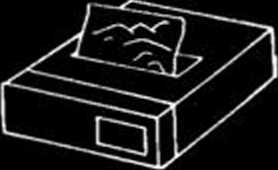5196105935
»
Video Camera of the 1990s?

As soPHisriCArri) as todays Home vkleo cam-eras are, they represent only ihe Iow er rungs on a ladder w hose top is clouded b) thc uncer-taimics o! the futurę. Occasionally thc clouds part, and we catch a glimpsc of something that liresour imugination Sony*s Mavica is such a product.
This prototype video camera uses a CCI) (chargc-coupled devicc) that yields an image composed ot a matris of 570 honzontal by 490 vertical electronic imaging points. The camera encodes the Information front the 279.300 poinls on the CCD and transfers it electrom-oalls to a liny frame on a Mavipak. uh ich is a magnetic disc that contains 50 frames within its 'A-inch thick by 2-inch squarc package.
The charge-coupled device—its es-scntially the same type employed in Sony*s \ ideo Movie Cameracordcr (see InFocus. November 1980)—uould be used as the cain-eras imaging device. About the size of a squared-off quarler. the CCD replaces sich standard imaging tubes as the vidicon. u h ich is typically used in todays homc video cam-eras Because thc imaging is electronic, you can previeu special proccsses—such as color altcrations or double exposures-bcfore ac-tually shooting.
The camera is a through-the-lcns (TTL) retlex design, employing a fast f/1.4 lens uiih a 16 to 64mm (1:4) zoom. Horizontal resolu-tion is rated at 350 lines. and \ ideo S/N at 45 dB. Including batters. it weighs slightly under two pounds: most film canieras weigh from three to four pounds
One major drauback to the current design is its liniited resolunon. which issubstan-tially less than that of a film print. But this problem is likely to be teniporary. sińce Sony and other companies (see InFocus. August) luve developed High-Definuion Television to the point where prototypes have been demon-strated at various electronic trade shows. (Picture quality approaches that of film.) Of course. lou defimtion would be a drauback only for those w ho u ished to make prints from the systeni-not for those u ho siniply wanted to use it as u video camera
Don’t cspect to find the Mavica in your neighborhood video shop for quite a while. Sony hus suggested sometinie in 1983 as the datę for its inlroduction. and then at a cost of S900 to S1,000. which. though in the middlc of the home video camera price rangę, is sub-siannally niore than today’s 35nim cameras.
/
Inside Sony’s Mavica System
MAVICA
MAVIPAK VIEWER
MAVIPAK

MAVIPAK TRANSMITTER
VIDEO-PICTURE PRINTER
VIDEO SCREEN
sir
su
FORTABLE VCR
a

MAVIPAK COPIER

•J

Fig. 2


VIDEO-PICTUR
PRINTER
RECEIVER
To the ummtiated eye, Sony‘s Mavica electronic imaging system looks like jusl another 35mni film camera. But this prototype electronic video “still” camera combines the liglit weight and cersatility of the faniiliar 35mm-film format uiih the unique flexibility of the vidco medium. Using a compact palm-sizcd magnetic disc pack (Mavipak). the camera can electromcally record up to 50 images. These can be viewed immediately on a standard tele-vision screcn. converted to a standard photo-graphic print via a special printer. transmitted to another location via phone modem, or sim-piy erased and recorded over. ith the capa-b il i ty of shooting ■still’’ pictures at a ratę of 60 frames per second. it can be used as a true portable vidco camera, linkcd to a VCR by a special cable.
53
DECEMBER 1981
Wyszukiwarka
Podobne podstrony:
Hunt the oceans instead of the classifieds. As an Airborne Electronics Analyst in the RAAF, you 11 f
The designation of the hijra as a loose-tongued upstart has continued to the pre-sent day, although
CCF20100223�000 1. Short and long i a. Short i, Le. (il % Fig. 7. Engjish
DSC03003 ;’s categories of human mind, the conceptual struć turę of the mind as rstood by cognitivis
Ittman 19 PHYSICAL CULTURE AND BHCATHING. >0 Exercisc No. 7. Stand ercct and place fiand on one s
directors, the ideals behind TPM for directors to maximise the joint welfare of the team as a whole
CONSTRUCTION OFTHE HEAD*34 THINK OF THE HEAD AS A ROUNDED MASS: ITIS EITHER BALL-SHAPED. PEAR-SHAPED
50989 skanuj0005 HYPERBOLA Fig. 1 The vertices and the asymptotes of the hyperbola as eonie section.
skanowanie0104 (2) organisation and content of the passage as well as its syntax. Ali those componen
39506 str (98) WILLIAMSOXS TREATMENT thtu ccTTtspondmę to B. At the beginning of th* paper be speaks
71962 TME$7 Richards, Franklin Son of Reed and Sue Richards of the Fani as nc Four, Franklin Richard
skanuj0012 Name: ID: A I 121. Rewrite the question as an indirect question. What time are Mum and Da
więcej podobnych podstron